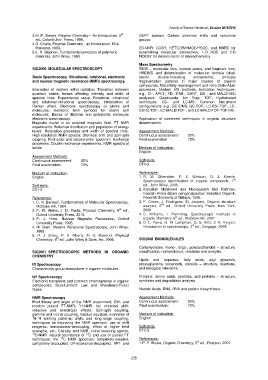Page 234 - handbook 20152016
P. 234
Faculty of Science Handbook, Session 2015/2016
rd
3. M. P. Steven, Polymer Chemistry – An Introduction, 3 DEPT spectra. Carbon chemical shifts and functional
ed., Oxford Univ. Press, 1999. groups.
4. G. Challa, Polymer Chemistry - an Introduction, Ellis
Horwood, 1993. 2D-NMR: COSY, HETCOR/HMQC/HSQC, and HMBC for
5. L. R. Stephen, Fundamental principles of polymeric establishing molecular connectivity; 1-D NOE and 2-D
materials, John Wiley, 1993. NOESY for determination of stereochemistry.
Mass Spectrometry
SIC2006 MOLECULAR SPECTROSCOPY EIMS – molecular ions, isotope peaks, and fragment ions;
HREIMS and determination of molecular formula (dual-
Basic Spectroscopy. Vibrational, rotational, electronic sector, double-focussing instruments); principal
and nuclear magnetic resonance (NMR) spectroscopy. fragmentation patterns in major classes of organic
compounds, McLafferty rearrangement and retro-Diels-Alder
Interaction of matters withd radiation. Transition between processes; Modern MS methods, ionization techniques:
quantum states; factors affecting intensity and width of e.g., CI-, APCI-, FD-, FAB-, DART, ESI-, and MALDI-MS;
spectral lines. Experimental setup. Rotational, vibrational analyzers: Quadrupole, Ion Trap, TOF; Hyphenated
and rotational-vibrational spectroscopy. Introduction of techniques: GC- and LC-MS: Common instrument
Raman effect. Electronic spectroscopy of atoms and configurations: e.g., GC-EIMS, GC-TOF-, LC-ESI-TOF-, LC-
molecules; electronic term symbols for atoms and ESI-Q-TOF-, LC-MALDITOF-, and LC-MALDITOF-TOF-MS.
molecules. Basics of diatomic and polyatomic molecular
electronic spectroscopy. Application of combined techniques in organic structure
Magnetic nuclei in an external magnetic field. FT NMR determination.
experiments. Boltzman distribution and population of energy
levels. Relaxation processes and width of spectral lines. Assessment Methods:
High resolution NMR spectra: chemical shift and spin-spin Continuous assessment: 30%
coupling. First-order and second-order spectrum. Exchange Final examination: 70%
processes. Double resonance experiments. NMR spectra of
solids. Medium of instruction:
English
Assessment Methods:
Continuous assessment: 30% Soft skills:
Final examination: 70% CT1-3
Medium of instruction: References:
English 1. R. M. Silverstein, F. X. Webster, D. J. Kiemle,
Spectroscopic identification of organic compounds, 7 th
Soft skills: ed., John Wiley, 2005.
CT1-3 2. Kamaliah Mahmood dan Noorsaadah Abd Rahman,
Kaedah Kimia dalam pengenalpastian Sebatian Organik,
References: Penerbit University of Malaya, 1998.
1. C. N. Banwell, Fundamentals of Molecular Spectroscopy, 3. P. Crews, J. Rodriguez, M. Jaspars, Organic structure
nd
McGraw Hill, 1994. analysis, 2 ed., Oxford University Press, New York,
th
2. P. W. Atkins, J. D. Paula, Physical Chemistry, 9 ed., 2009.
Oxford University Press, 2010. 4. D. Williams, I. Flemming, Spectroscopic methods in
th
3. P. J. Hore, Nuclear Magnetic Resonance, Oxford organic chemistry, 6 ed., McGraw-Hill, 2007.
University Press, 1995. 5. D. L. Pavia, G. M. Lampman, G. S. Kritz, J. A. Vyvyan,
th
4. M. Diem, Modern Vibrational Spectroscopy, John Wiley, Introduction to spectroscopy, 4 ed., Cengage, 2009.
1993.
5. R. J. Silbey, R. A. Alberty, M. G. Bawendi, Physical
th
Chemistry, 4 ed., John Wiley & Sons, Inc, 2005. SIC2008 BIOMOLECULES
Carbohydrates: mono-, oligo-, polysaccharides – structure,
SIC2007 SPECTROSCOPIC METHODS IN ORGANIC classification, nomenclature, reactions and analysis.
CHEMISTRY
Lipids and terpenes: fatty acids, acyl glycerols,
IR Spectroscopy prostaglandins, terpenoids, steroids – structure, reactions,
Characteristic group absorptions in organic molecules. and biological relevance.
UV Spectroscopy Proteins: amino acids, peptides, and proteins – structure,
Electronic transitions and common chromophores in organic synthesis and degradation analysis.
compounds; Beer-Lambert Law and Woodward-Fieser
Rules. Nucleic Acids: DNA, RNA and protein biosynthesis.
NMR Spectroscopy Assessment Methods:
Brief theory and origin of the NMR experiment; CW- and Continuous assessment: 30%
1
modern pulsed FT-NMR; H-NMR: the chemical shift: Final examination: 70%
inductive and anisotropic effects; Spin-spin coupling:
geminal and vicinal coupling, Karplus equation; examples of Medium of instruction:
1 1
H- H splitting patterns; allylic and long-range coupling; English
techniques for improving the NMR spectrum: use of shift
reagents; homonuclear-decoupling; effect of higher field Soft skills:
strengths, etc.; Chirality and NMR: chiral resolving agents; CT1-3
13 13
C-NMR: natural abundance of C and use of pulsed FT
techniques; the 13 C NMR spectrum: completely-coupled, References:
th
completely-decoupled; off-resonance-decoupled; APT and 1. P. Y. Bruice, Organic Chemistry, 5 ed., Pearson, 2007.
225

